Experimental and Computer Simulation Studies on Badminton Racquet Strings
Abstract
1. Introduction
2. Experimental Program
2.1. Badminton Racquets and Shuttlecocks
2.2. Test Setup
2.2.1. Accelerometer and Fast Fourier Transformation (FFT) Analyzer
2.2.2. Shuttlecock Shooting Machine and Speed Measurements
3. Analysis of Test Results
3.1. Effect of Location of Hitting Points on Badminton Racquet
3.2. Effect of String Diameter and Tension of String
3.2.1. Effect of String Diameter
3.2.2. Effect of Tension of String
3.3. Effect of String Pattern
3.4. Effect of Distance between Cock and Badminton Racquet
3.5. Tradeoff between Power and Control with String Tension
3.6. Main Observations for Analysis
4. Numerical Simulations for Impact Analysis
4.1. FE Geometry, Meshing, and Material Properties
4.2. Loading and Boundary Conditions
4.3. Analysis Procedure
5. Analytical Calculations
5.1. Analysis of Natural Frequency
5.2. Impact Analysis
5.3. Compariosn of Predicted Natural Frequencies vs. Analytical Values
5.4. Comfort Tests with Actual Players
6. Conclusions
- The natural frequency of a racquet with Kevlar strings was significantly higher than that of racquets with synthetic gut, natural gut, or polyester string materials. Specifically, the natural frequency of a racquet made of carbon graphite and epoxy resin was 23.0%, 30.7%, and 36.2% higher than that of racquets with synthetic gut, natural gut, and polyester string material, respectively.
- The change in string tension can have a significant impact on shuttlecock speed, with an increase or decrease of up to an average of 10%. This factor can influence achievement and potentially provide an advantage to athletes during a competition. The study found that increasing the string tension could decrease the elasticity of the string by up to an average of 15%. Similarly, increasing the string diameter also decreased the elasticity of the string by up to an average of 20%.
- The center of the racquet, being the point of maximum impact, accounts for up to an average of 57% of the total impact force. Additionally, the translational and rotational contributions to shuttlecock speed can be retained, providing some information about player strength and skill.
- Overall, understanding the effects of different factors on racquet and shuttlecock performance can help players and coaches make more informed decisions and improve their performance on the playing court. The experimental and FE results in this study suggest that ad hoc tuning of string tension and string diameter can potentially lead to better racquet performance. Moreover, measuring the kinematics of the racquet can provide further insight into both player and racquet’s performance.
Supplementary Materials
Author Contributions
Funding
Institutional Review Board Statement
Informed Consent Statement
Data Availability Statement
Acknowledgments
Conflicts of Interest
Appendix A. Equation Derivation of Natural Frequency

Appendix B. Equation Derivation of Maximum Deflection and Maximum Stress during Collision
Appendix C. Test Result of Acceleration vs. Time


Appendix D. FEA Result of Frequency of Badminton Racquet for Different Modes

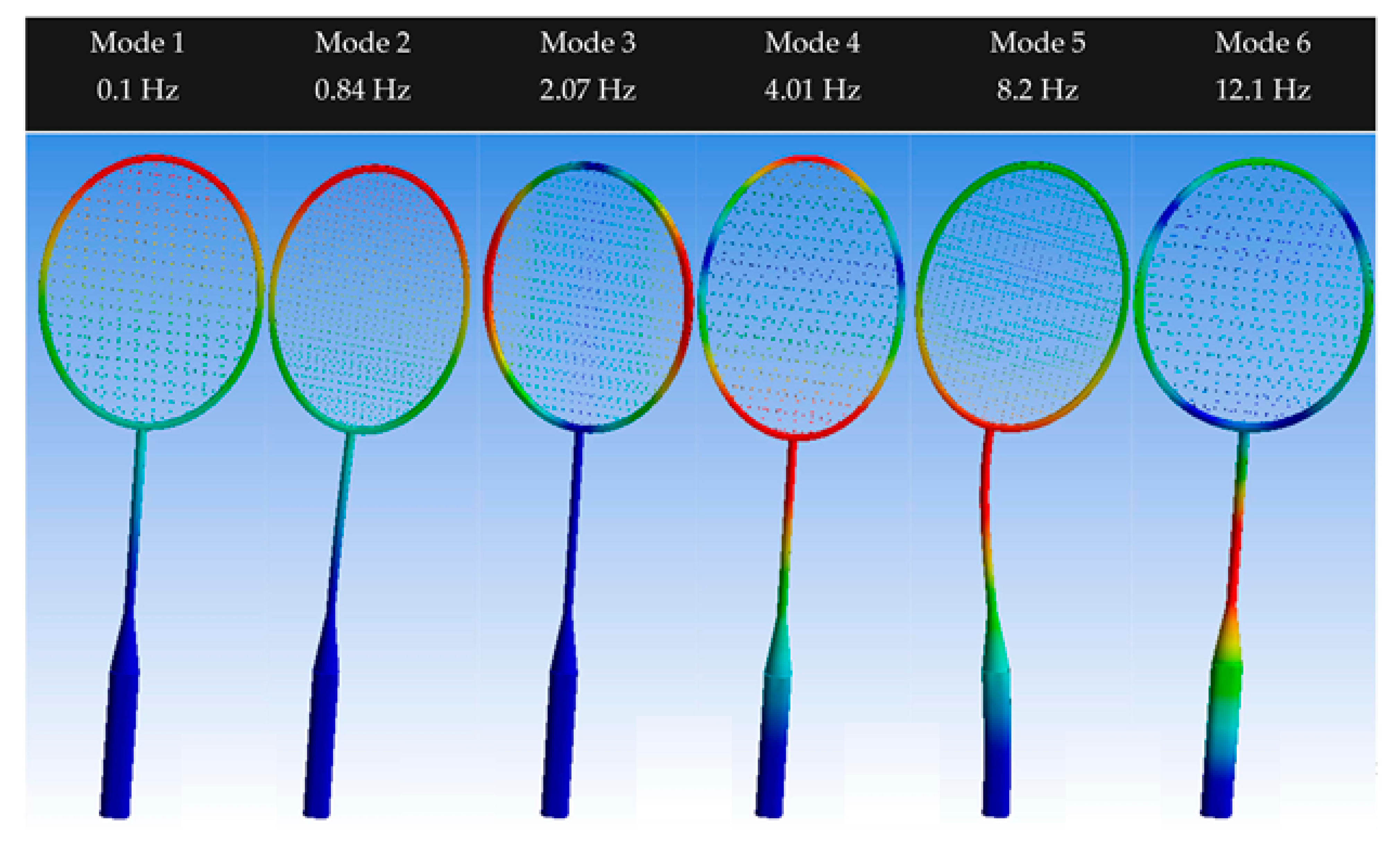


References
- Cohen, C.; Clanet, C. Physics of ball sports. Eur. News 2016, 47, 13–16. [Google Scholar] [CrossRef]
- Liu, Y. Project Application in the Field of Composite Materials in Badminton. Appl. Mech. Mater. 2014, 644–650, 4802–4804. [Google Scholar] [CrossRef]
- Nasruddin, F.; Harun, M.; Syahrom, A.; Abdul Kadir, M.; Omar, A. Finite Element Analysis on Badminton Racquet Design Parameters; Springer: Berlin/Heidelberg, Germany, 2015; pp. 1–47. [Google Scholar]
- Kwan, M.M.S. Designing the World’s Best Badminton Racquet. Ph.D. Thesis, Aalborg University, Aalborg, Denmark, 2010. [Google Scholar]
- Elliott, B. Biomechanics: An integral part of sport science and sport medicine. J. Sci. Med. Sport/Sport. Med. Aust. 2000, 2, 299–310. [Google Scholar] [CrossRef]
- Arianto, I.; Nuri, N.; Yulianto, A. Effect of the Pull and Diameter String of Badminton Racquet Based on Coeffisient of Restitution Value. J. Nat. Sci. Math. Res. 2017, 1, 85. [Google Scholar] [CrossRef]
- Vanasant, T.; Mingkhumlert, S.; Limroongreungrat, W. The effect of string tension on shuttlecock velocity. In Proceedings of the ISBS-Conference Proceedings Archive: International Conference on Biomechanics in Sports (2013), Taipei, Taiwan, 7–11 July 2013. [Google Scholar]
- Kwan, M.; Cheng, C.L.; Tang, W.T.; Rasmussen, J. Measurement of badminton racket deflection during a stroke. Sport. Eng. 2010, 12, 143–153. [Google Scholar] [CrossRef]
- Bower, R.; Cross, R. String tension effects on tennis ball rebound speed and accuracy during playing conditions. J. Sports Sci. 2005, 23, 765–771. [Google Scholar] [CrossRef] [PubMed]
- Cross, R. Flexible beam analysis of the effects of string tension and frame stiffness on racquet performance. Sports Eng. 2000, 3, 111–122. [Google Scholar] [CrossRef]
- Blomstrand, E.; Demant, M. Simulation of a Badminton Racket. A Parametric Study of Racket Design Parameters Using Finite Element Analysis. Master’s Thesis, Applied Mechanics. Department of Applied Mechanics, Chalmers University of Technology, Goteborg, Sweden, 2017. Available online: https://hdl.handle.net/20.500.12380/250350 (accessed on 12 May 2023).
- Zhu, Q. Perceiving the affordance of string tension for power strokes in badminton: Expertise allows effective use of all string tensions. J. Sports Sci. 2013, 31, 1187–1196. [Google Scholar] [CrossRef]
- Li, L.; Yang, S.; Hwang, C.-S.; Kim, Y.-S. Effects of string tension and impact location on tennis playing. J. Mech. Sci. Technol. 2009, 23, 2990–2997. [Google Scholar] [CrossRef]
- Fernandez-Fernandez, J.; Lopez-Valenciano, A.; Garcia-Tormo, J.V.; Cabello-Manrique, D.; García-López, J. Acute effects of 2 consecutive simulated badminton matches on the shoulder range of motion and isometric strength of elite youth players. Int. J. Sport. Physiol. Perform. 2021, 16, 1447–1453. [Google Scholar] [CrossRef]
- Alam, F.; Chowdhury, H.; Theppadungporn, C.; Moria, H.; Subic, A. A Comparative Study of Feather and Synthetic Badminton Shuttlecock Aerodynamics. In Proceedings of the 17th Australasian Fluid Mechanics Conference, Auckland, New Zealand, 5–9 December 2010. [Google Scholar]
- Solanki, H.; Gill, M. The Effect of Core Stability Training on Dynamic Balance and Smash Stroke Performance in Badminton Players—An Evidence Based Study. Int. J. Sci. Heal. Res. 2021, 6, 93–98. [Google Scholar] [CrossRef]
- Groppel, J.L.; Shin, I.-S.; Thomas, J.A.; Welk, G.J.J.J.o.A.B. The effects of string type and tension on impact in midsized and oversized tennis racquets. Int. J. Sport Biomech. 1987, 3, 40–46. [Google Scholar] [CrossRef]
- Fakhrizal, A.N.; Ardiyansyah, S.; Harun, M.N.; Kadir, M.R.A.; Omar, A.H. Finite-Element Study on Effect of String Tension toward Coefficient of Restitution of a Badminton Racquet String-Bed. Adv. Mater. Res. 2013, 845, 417–420. [Google Scholar] [CrossRef]
- Che Hassan, M.F.; Rosli, M.U.; Redzuan, M. Material selection in a sustainable manufacturing practice of a badminton racquet frame using Elimination and Choice Expressing Reality (ELECTRE) Method. J. Phys. Conf. Ser. 2018, 1020, 012012. [Google Scholar] [CrossRef]
- Troiano, R.; McClain, J.; Brychta, R.; Chen, K. Evolution of accelerometer methods for physical activity research. Br. J. Sports Med. 2014, 48, 1019–1023. [Google Scholar] [CrossRef] [PubMed]
- Betta, G.; D’Apuzzo, M.; Liguori, C.; Pietrosanto, A. An intelligent FFT-analyzer. Instrum. Meas. IEEE Trans. 1998, 47, 1173–1179. [Google Scholar] [CrossRef]
- Chayanon, H.; Suchart, L.; Hexin, Z.; Thanongsak, I. Residual Strength of Reinforced Concrete Beams under Sequential Small Impact Loads. Buildings 2021, 11, 518. [Google Scholar] [CrossRef]
- Aslam, M.; Bashir, A.; Draz, W.; Raja, H.; Kamran. Optimized Shuttlecock Propulsion Machine to Facilitate Badminton Training. In Proceedings of the 2019 International Conference on Electrical, Communication, and Computer Engineering (ICECCE), Swat, Pakistan, 24–25 July 2019; pp. 1–6. [Google Scholar] [CrossRef]
- Buccolini, L.; Conti, M. An Energy Harvester Interface for Self-Powered Wireless Speed Sensor. IEEE Sens. J. 2016, 17, 1097–1104. [Google Scholar] [CrossRef]
- Jiang, C.; Liang, F. Research on the Sports Economy Effection in National Economic Development. Appl. Mech. Mater. 2014, 556–562, 6519–6521. [Google Scholar] [CrossRef]
- Brownjohn, J.; Zheng, X. Discussion of human resonant frequency. In Proceedings of the Second International Conference on Experimental Mechanics, Singapore, 29 November—1 December 2000. [Google Scholar] [CrossRef]
- Brito, W.; Maia, C.D.C.D.; Mendonca, A. Bending analysis of elastically connected Euler-Bernoulli double-beam system using the direct boundary element method. Appl. Math. Model. 2019, 74, 387–408. [Google Scholar] [CrossRef]
- Suchart, L.; Worathep, S.; Hamid, M.; Jaroon, R.; Piti, S.; Thanongsak, I.; Hexin, Z. Static and Free Vibration Analyses of Single-Walled Carbon Nanotube (SWCNT)–Substrate Medium Systems. Nanomaterials 2022, 12, 1740. [Google Scholar] [CrossRef]
- Harita, B.; GopichandMaia, A.; Krishna, M. Fabrication and Impact Analysis of Femur Bone. Int. J. Eng. Dev. Res. 2018, 6, 667–674. Available online: https://ijedr.org/papers/IJEDR1803111.pdf (accessed on 12 May 2023).
- Tencer, A.; Kaufman, R.; Ryan, K.; Grossman, D.; Henley, B.; Mann, F.; Mock, C.; Rivara, F.; Wang, S.; Augenstein, J. Femur fractures in relatively low speed frontal crashes: The possible role of muscle forces. Accid. Anal. Prev. 2002, 34, 1–11. [Google Scholar] [CrossRef]
- Takizawa, M.; Matsuda, A.; Hashiguchi, T. A Study on the Mechanical Characteristics of String Planes of Badminton Racquets by Nonlinear Finite Element Analysis. In Proceedings of the 13th Conference of the International Sports Engineering Association, Tokyo, Japan, 22–26 June 2020; Volume 49. [Google Scholar] [CrossRef]
- Lu, Z.; Zhou, L.; Gong, W.; Chuang, S.; Wang, S.; Guo, Z.; Bao, D.; Zhang, L.; Zhou, J. The effect of 6-week combined balance and plyometric training on dynamic balance and quickness performance of elite badminton players. Int. J. Environ. Res. Public Health 2022, 19, 1605. [Google Scholar] [CrossRef]
- Wang, Y.; Wu, X.; Chen, H. Badminton Improves Executive Function in Adults Living with Mild Intellectual Disability. Int. J. Environ. Res. Public Health 2023, 20, 3673. [Google Scholar] [CrossRef] [PubMed]
- King, M.; Towler, H.; Dillon, R.; McErlain-Naylor, S. A correlational analysis of shuttlecock speed kinematic determinants in the badminton jump smash. Appl. Sci. 2020, 10, 1248. [Google Scholar] [CrossRef]
- Gomez, M.Á.; Rivas, F.; Connor, J.D.; Leicht, A.S. Performance differences of temporal parameters and point outcome between elite men’s and women’s badminton players according to match-related contexts. Int. J. Environ. Res. Public Health 2019, 16, 4057. [Google Scholar] [CrossRef]
- Liu, H.; Leng, B.; Li, Q.; Liu, Y.; Bao, D.; Cui, Y. The effect of eight-week sprint interval training on aerobic performance of elite badminton players. Int. J. Environ. Res. Public Health 2021, 18, 638. [Google Scholar] [CrossRef] [PubMed]
- Steels, T.; Van Herbruggen, B.; Fontaine, J.; De Pessemier, T.; Plets, D.; De Poorter, E. Badminton activity recognition using accelerometer data. Sensors 2020, 20, 4685. [Google Scholar] [CrossRef]
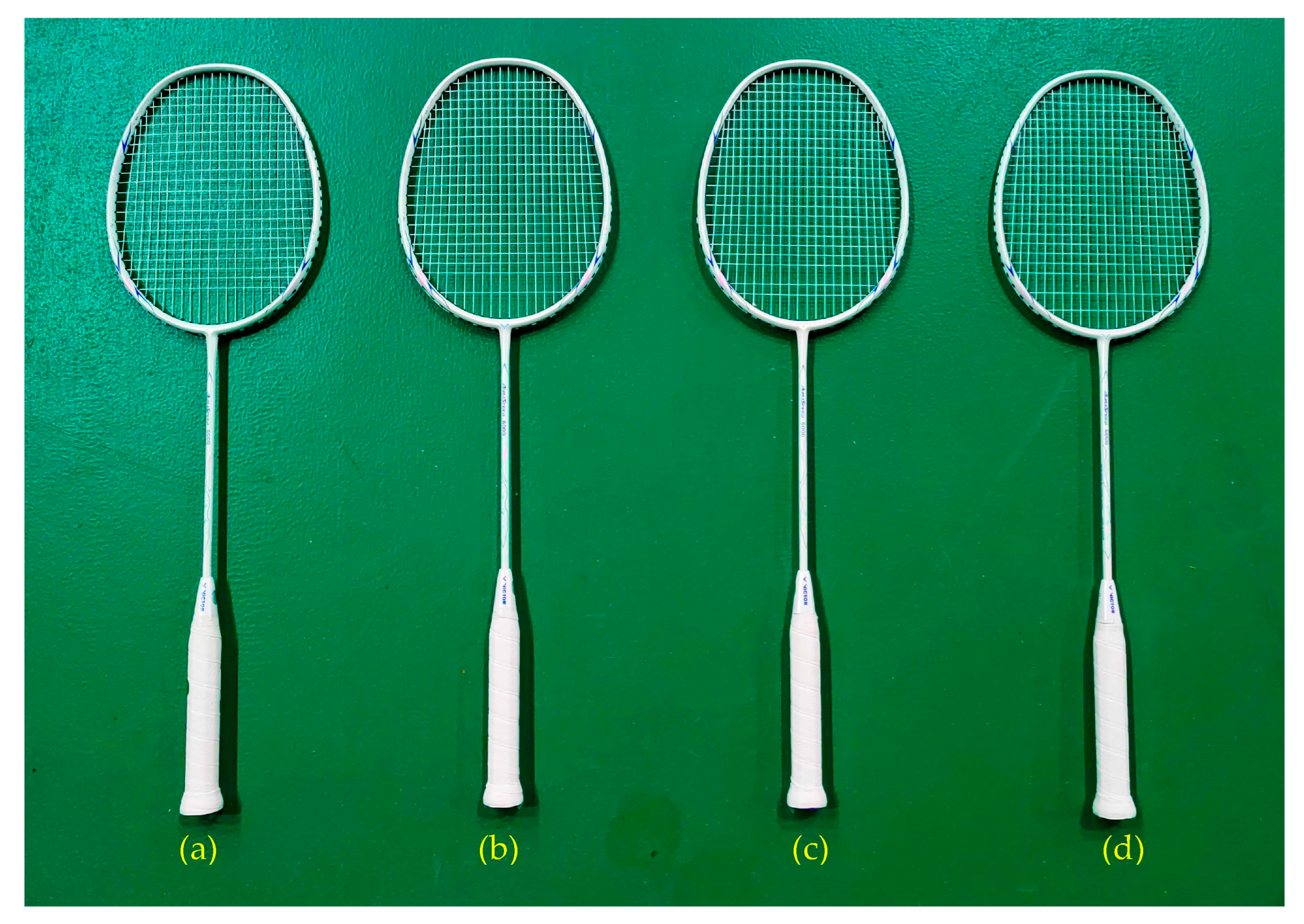



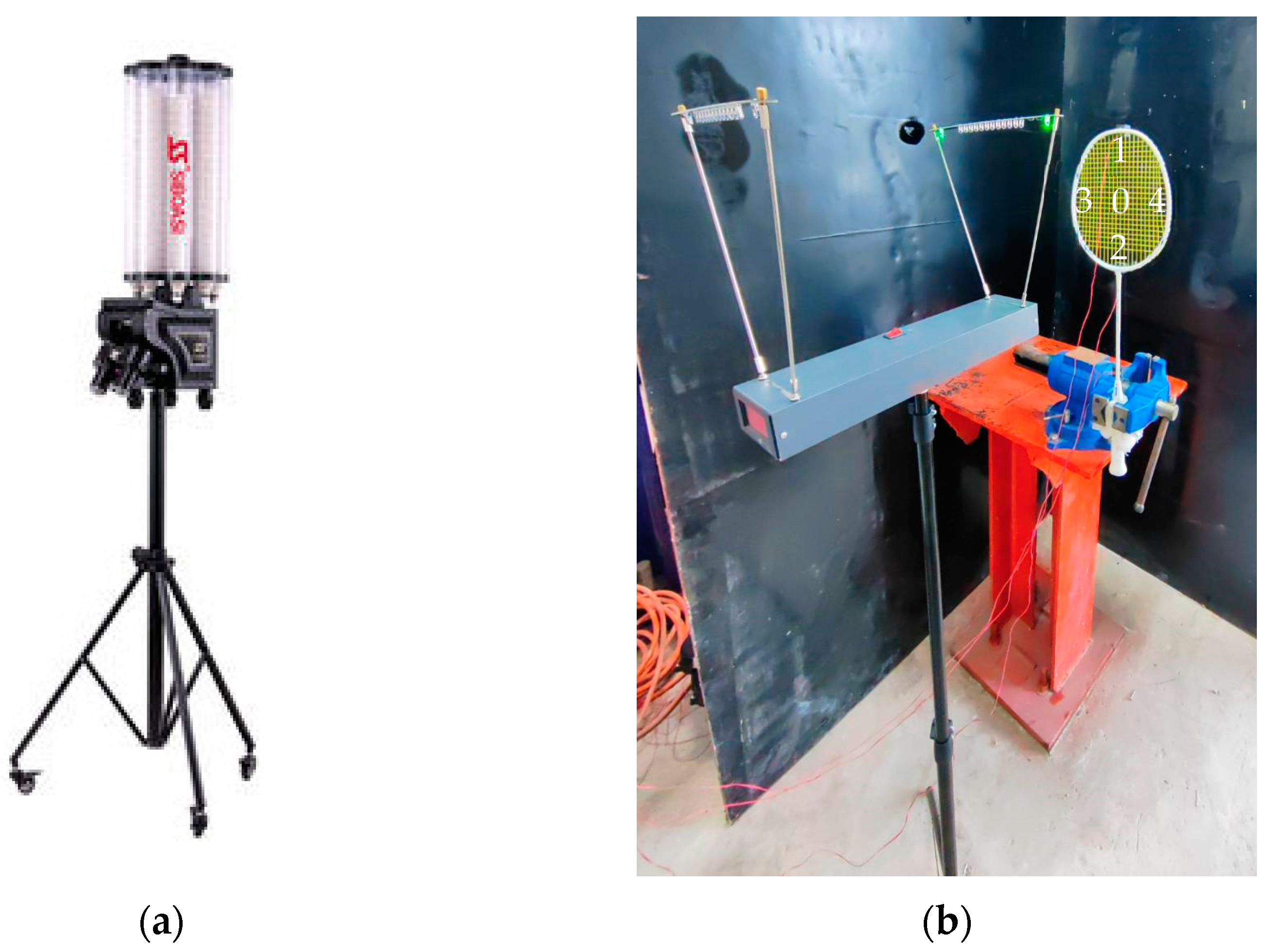




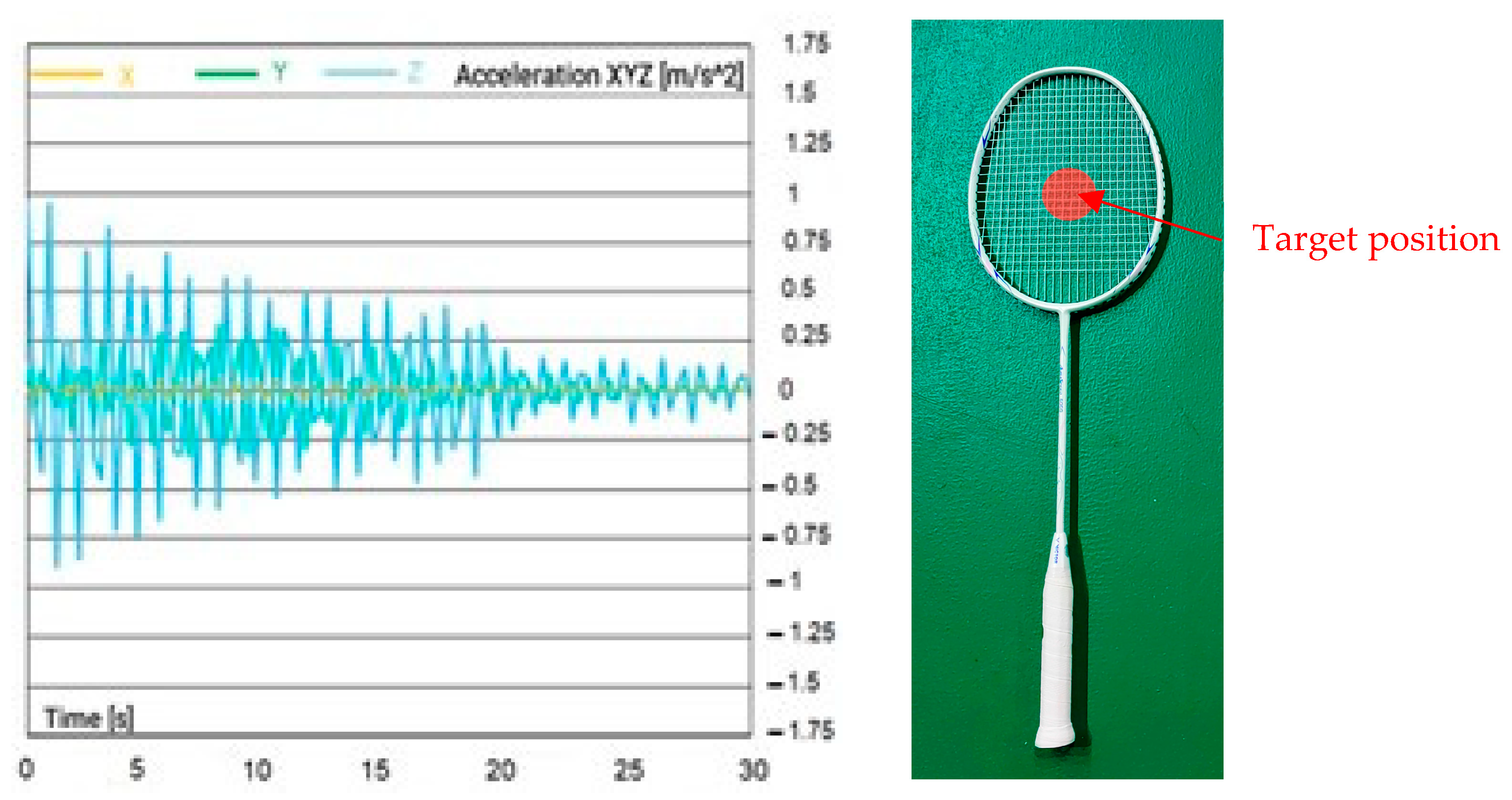





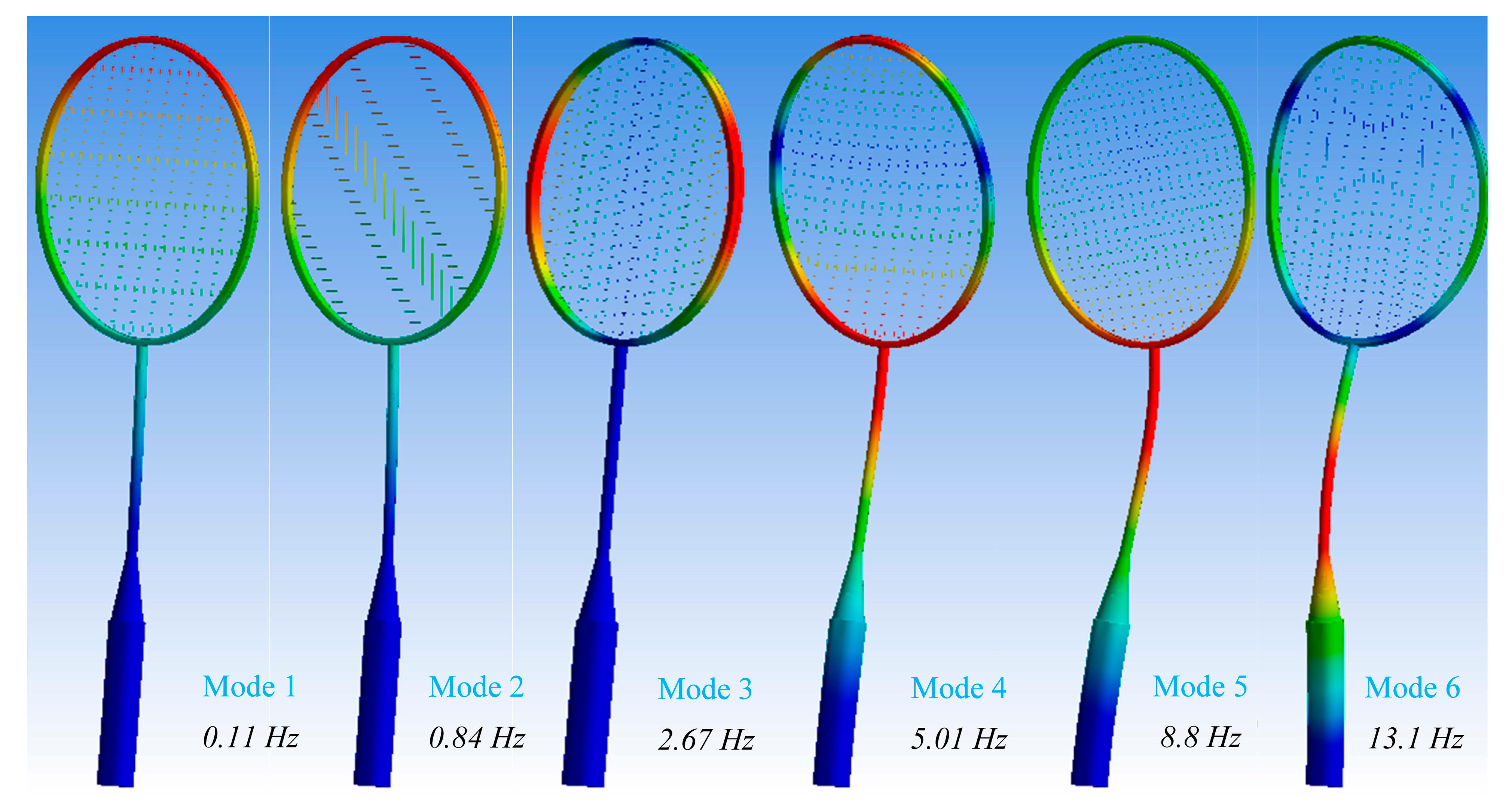


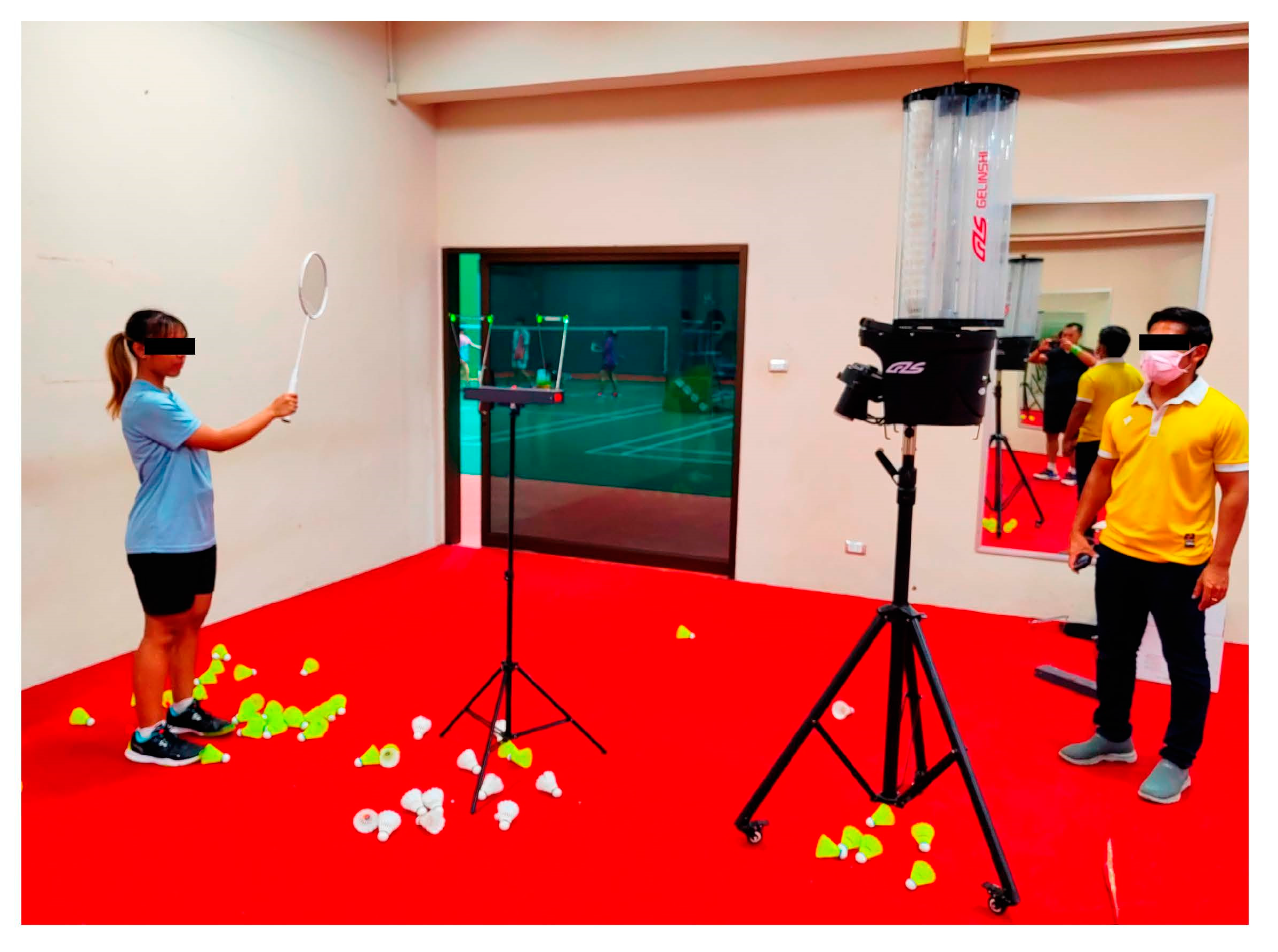
| Sample No. | Yonex Shuttlecock Aerosensa Series | ||||
|---|---|---|---|---|---|
| AS-10 | AS-20 | AS-30 | AS-40 | AS-50 | |
| 1 | 5.159 | 5.062 | 5.102 | 5.049 | 4.860 |
| 2 | 5.185 | 5.013 | 5.156 | 5.057 | 4.892 |
| 3 | 5.255 | 4.916 | 5.137 | 4.937 | 5.021 |
| 4 | 5.249 | 5.141 | 5.144 | 5.008 | 4.971 |
| 5 | 5.146 | 5.030 | 5.181 | 5.006 | 4.888 |
| 6 | 5.245 | 4.991 | 5.021 | 5.054 | 4.878 |
| 7 | 5.124 | 4.954 | 5.120 | 4.965 | 4.927 |
| 8 | 5.131 | 4.889 | 5.036 | 5.114 | 4.918 |
| 9 | 5.208 | 5.066 | 5.125 | 5.118 | 4.869 |
| 10 | 5.190 | 4.973 | 5.170 | 5.092 | 4.832 |
| Average | 5.193 | 5.004 | 5.119 | 5.041 | 4.906 |
| SD. | 0.048 | 0.072 | 0.051 | 0.057 | 0.053 |
| 3 m | 5 m | 8 m | |||
|---|---|---|---|---|---|
| Position 1 | Position 2 | Position 1 | Position 2 | Position 1 | Position 2 |
| 93.4 m/s | 91.4 m/s | 93.1 m/s | 87.4 m/s | 92.9 m/s | 82.8 m/s |
| Tension per Single String (lb) | Tension (N) | Speed (m/s) | Power (kJ/s) |
|---|---|---|---|
| 20 | 89 | 91.4 | 8.14 |
| 22 | 97.9 | 87.1 | 8.52 |
| 24 | 106.8 | 86.0 | 9.19 |
| 28 | 124.6 | 84.1 | 10.47 |
| 30 | 133.5 | 82.5 | 11.02 |
| 34 | 151.3 | 79.2 | 11.95 |
| String Material | Mode 1 | Mode 2 | Mode 3 | Mode 4 | Mode 5 | Mode 6 |
|---|---|---|---|---|---|---|
| Synthetic gut | 0.11 Hz | 0.84 Hz | 2.67 Hz | 5.01 Hz | 8.8 Hz | 13.1 Hz |
| Natural gut | 0.1 Hz | 0.84 Hz | 2.07 Hz | 4.01 Hz | 8.2 Hz | 12.1 Hz |
| Kevlar | 0.16 Hz | 1.14 Hz | 3.67 Hz | 7.01 Hz | 10.8 Hz | 15.1 Hz |
| Polyester | 0.09 Hz | 0.84 Hz | 1.70 Hz | 4.13 Hz | 8.08 Hz | 11.01 Hz |
(Hz) | Type of String Material | |||
|---|---|---|---|---|
| Nylon | Natural Gut | Kevlar | Polyester | |
| 0.1 | 0.09 | 0.13 | 0.083 | |
| 0.81 | 0.71 | 0.99 | 0.658 | |
| 2.49 | 1.53 | 3.45 | 1.334 | |
| 4.88 | 3.95 | 6.79 | 3.575 | |
| 8.06 | 7.6 | 9.93 | 7.563 | |
| 12.05 | 11.2 | 14.84 | 10.3 | |
| Impact Points | Nylon String | Natural Gut String | Kevlar String | Polyester String | ||||
|---|---|---|---|---|---|---|---|---|
| δmax (mm) | σmax (MPa) | δmax (mm) | σmax (MPa) | δmax (mm) | σmax (MPa) | δmax (mm) | σmax (MPa) | |
| 0 | 5.8 | 451.3 | 8.30 | 560.0 | 4.36 | 546.35 | 10.1 | 419.3 |
| 1 | 2.7 | 417.2 | 3.40 | 530.0 | 2.45 | 526.44 | 3.9 | 492.7 |
| 2 | 2.1 | 439.0 | 4.71 | 491.2 | 1.74 | 476.6 | 5.8 | 456.9 |
| 3 | 2.5 | 447.0 | 3.03 | 457.4 | 2.08 | 447.03 | 4.1 | 441.6 |
| 4 | 2.2 | 453.3 | 3.15 | 461.8 | 2.03 | 453.74 | 4.2 | 460.9 |
Disclaimer/Publisher’s Note: The statements, opinions and data contained in all publications are solely those of the individual author(s) and contributor(s) and not of MDPI and/or the editor(s). MDPI and/or the editor(s) disclaim responsibility for any injury to people or property resulting from any ideas, methods, instructions or products referred to in the content. |
© 2023 by the authors. Licensee MDPI, Basel, Switzerland. This article is an open access article distributed under the terms and conditions of the Creative Commons Attribution (CC BY) license (https://creativecommons.org/licenses/by/4.0/).
Share and Cite
Suwannachote, N.; Imjai, T.; Wattanapanich, C.; Kefyalew, F.; Garcia, R.; Aosai, P. Experimental and Computer Simulation Studies on Badminton Racquet Strings. Sensors 2023, 23, 5957. https://doi.org/10.3390/s23135957
Suwannachote N, Imjai T, Wattanapanich C, Kefyalew F, Garcia R, Aosai P. Experimental and Computer Simulation Studies on Badminton Racquet Strings. Sensors. 2023; 23(13):5957. https://doi.org/10.3390/s23135957
Chicago/Turabian StyleSuwannachote, Narakorn, Thanongsak Imjai, Chirawat Wattanapanich, Fetih Kefyalew, Reyes Garcia, and Pakjira Aosai. 2023. "Experimental and Computer Simulation Studies on Badminton Racquet Strings" Sensors 23, no. 13: 5957. https://doi.org/10.3390/s23135957
APA StyleSuwannachote, N., Imjai, T., Wattanapanich, C., Kefyalew, F., Garcia, R., & Aosai, P. (2023). Experimental and Computer Simulation Studies on Badminton Racquet Strings. Sensors, 23(13), 5957. https://doi.org/10.3390/s23135957








